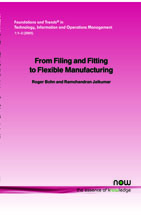From Art to Science in Manufacturing: The Evolution of Technological Knowledge
By Roger E. Bohn,
Abstract
Making goods evolved over several centuries from craft production to complex and highly automated manufacturing processes. A companion paper by R. Jaikumar documents the transformation of firearms manufacture through six distinct epochs, each accompanied by radical changes in the nature of work. These shifts were enabled by corresponding changes in technological knowledge. This paper models knowledge about manufacturing methods as a directed graph of cause–effect relationships. Increasing knowledge corresponds to more numerous variables (nodes) and relationships (arcs). The more dense the graph, the more variables can be monitored and controlled, with greater precision. This enables higher production speeds, tighter tolerances, and higher quality.
Changes in knowledge from epoch to epoch tend to follow consistent patterns. More is learned about key classes of phenomena, including measurement methods, feedback control methods, and disturbances. As knowledge increases, control becomes more formal, and operator discretion is reduced or shifted to other types of activity. Increasing knowledge and control are two dimensions of a shift from art towards science.
Evolution from art to science is not monotonic. The knowledge graphs of new processes are riddled with holes; dozens of new variables must be identified, understood, and controlled. Frederick Taylor pioneered three key methods of developing causal knowledge in such situations: reductionism, using systems of quantitative equations to express knowledge, and learning by systematic experimentation. Using causal networks to formally model knowledge appears to also fit other kinds of technology. But even as vital aspects of manufacturing verge on "full science," other technological activities will remain nearer to art, as for them complete knowledge is unapproachable.
From Filing and Fitting to Flexible Manufacturing
From Filing to Fitting in Flexible Manufacturing is based on a well-known but previously unpublished monograph by Ramchandran Jaikumar on the nature and history of manufacturing. The development of mass manufacturing ranks as one of the most important contributors to human living conditions ever - of the same magnitude as agriculture and modern medicine. This monograph examines the development of manufacturing over several centuries, through the eyes of a single industry and company. Throughout this period, the key has been precise control of manufacturing processes, rather than production speed per se. There have been six revolutionary transformations in manufacturing, each involving a shift in hard technology, the nature of human work, and the nature of process control. Each epochal change was a step in the evolution of manufacturing from art to science. Each required a different ethos of process control and forced a new system of manufacture. Machines, the nature of work, and the nature of the organization all had to change in concert. A companion paper by Roger Bohn expands the concept of transition from art to science to encompass two more-or-less parallel shifts: in the nature of procedures, and in the level of technological knowledge. The level of knowledge can be modeled as a directed graph that maps current understanding of causality in the manufacturing process. As a process moves from art towards science, knowledge and its causal graph become more elaborate: new nodes are added, new relationships are established among new and existing nodes, and wholly new issues emerge and are gradually integrated with existing knowledge.

Companion
From Filing and Fitting to Flexible Manufacturing: A Study in the Evolution of Process Control , Foundations and Trends® in Technology, Information and Operations Management, Volume 1, Issue 1 10.1561/0200000001